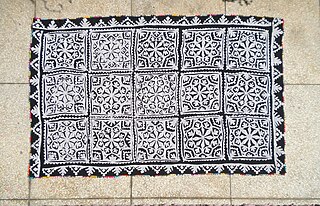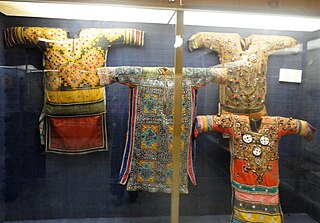
A sari is a women's garment from the Indian subcontinent. It consists of an un-stitched stretch of woven fabric arranged over the body as a robe, with one end attached to the waist, while the other end rests over one shoulder as a stole, sometimes baring a part of the midriff. It may vary from 4.1 to 8.2 metres in length, and 60 to 120 centimetres in breadth, and is a form of ethnic wear in Bangladesh, India, Sri Lanka, Nepal, and Pakistan. There are various names and styles of sari manufacture and draping, the most common being the Nivi style. The sari is worn with a fitted bodice also called a choli and a petticoat called ghagra, parkar, or ul-pavadai. It remains fashionable in the Indian subcontinent today.

Textile printing is the process of applying color to fabric in definite patterns or designs. In properly printed fabrics the colour is bonded with the fibre, so as to resist washing and friction. Textile printing is related to dyeing but in dyeing properly the whole fabric is uniformly covered with one colour, whereas in printing one or more colours are applied to it in certain parts only, and in sharply defined patterns.

The wrapper, lappa, or pagne is a colorful garment widely worn in West Africa by both men and women. It has formal and informal versions and varies from simple draped clothing to fully tailored ensembles. The formality of the wrapper depends on the fabric used to create or design it.

Ralli,Rilli or Rillki quilts are traditional quilts of Sindh, in southeastern Pakistan, and the surrounding regions bordered by the Bahawalpur region of Punjab, Rajasthan and the Kutch region of Gujarat. Traditionally, they were made of cotton, but synthetic fabrics have increasingly been used since the late 1900s. The types, colors, and designs of ralli quilts vary depending upon the area in which they are made. There are different types of ralli making, three of which are widely known. These include appliqué, patchwork, and embroidered ralli. All rallis are handmade by women artisans of Sindh's remote areas. Embroidery designs and motifs indicate the nature, geometric and floral patterns from the area's ancient civilizations. Mothers used to explain several inheritance patterns to their daughters.

Resist dyeing (resist-dyeing) is a traditional method of dyeing textiles with patterns. Methods are used to "resist" or prevent the dye from reaching all the cloth, thereby creating a pattern and ground. The most common forms use wax, some type of paste made from starch or mud, or a mechanical resist that manipulates the cloth such as tying or stitching. Another form of resist involves using a dye containing a chemical agent that will repel another type of dye printed over the top. The best-known varieties today include tie-dye, batik, and ikat.

The state of Oaxaca in southern Mexico has a noteworthy tradition of finely crafted textiles, particularly handmade embroidery and woven goods that frequently use a backstrap loom. Oaxaca is home to several different groups of indigenous peoples, each of which has a distinctive textile tradition.
Pakistani clothing refers to the ethnic clothing that is typically worn by people in the country of Pakistan and by Pakistanis. Pakistani clothes express the culture of Pakistan, the demographics of Pakistan, and cultures from Punjab, Sindh, Balochistan, Khyber Pakhtunkhwa, Gilgit-Baltistan, and Kashmir regions of the country. The clothing in each region and culture of Pakistan reflect weather conditions, way of living, the textiles and embroidery used and its distinctive style which gives it a unique identity among all cultures.

The Culture of Sindh has its roots in the Indus Valley civilization. Sindh has been shaped by the largely desert region, the natural resources it has available, and continuous foreign influence. The Indus or Sindhu River, which passes through the land, and the Arabian Sea also supported the seafaring traditions among the local people. The local climate also reflects why the Sindhis have a language, folklore, traditions, customs, and lifestyle that are so different from the neighbouring regions. The Sindhi culture is also practised by the Sindhi diaspora.

The Sindhi cap, locally called Sindhī ṭopī is a skullcap worn predominantly by Sindhis in Sindh, Pakistan. Together with Ajrak, the Sindhi cap is regarded as an essential part of Sindhi culture.

The crafts of India are diverse, rich in history, culture and religion. The craft of each state in India reflect the influence of different empires. Throughout centuries, crafts have been embedded as a culture and tradition within rural communities.

Sindhi clothing are a part of the Sindhi culture. Sindhi women and men wear the Shalwar Qameez or the Kurta with Pyjama. Women also wear Sari or ghagra. However, before the adoption of the Shalwar kameez, kurta, the Sari as well as other articles of clothing, Sindhis had their own traditional costumes.

Bagh print is a traditional Indian handicraft originating in Bagh, Dhar district of Madhya Pradesh, India. The process is characterised by hand printed wood block relief prints with naturally sourced pigments and dyes. Bagh print motifs are typically geometric, paisley, or floral compositions design, dyed with vegetable colours of red and black over a white background, and is a popular textile printing product. Its name is derived from the village Bagh located on the banks of the Bagh River.

Sajarak also known as Saraiki ajrak is a form of block-printing, inspired by the Sindhi Ajrak, found in South Punjab in Pakistan. It has become a symbol of the Saraiki culture and traditions.
There are two types of Saraiki shalwar suits which originate in the southern area of Punjab, Pakistan. These are the Bahawalpuri shalwar suit and the Multani shalwar suit. The two main suits from that area.
Mabel Phyllis Barron was an English designer, known for her textile printing workshop with Dorothy Larcher. These textiles are ‘noted for the assurance and originality of the designs, their distinctive and subtle colouring, and the quality of the materials selected’
Sindhi Cultural Day is a popular Sindhi cultural festival. It is celebrated with traditional enthusiasm to highlight the centuries-old rich culture of Sindh. The day is celebrated each year in the first week of December on the Sunday. It's widely celebrated all over Sindh, and amongst the Sindhi diaspora population around the world. Sindhis celebrate this day to demonstrate the peaceful identity of Sindhi culture and acquire the attention of the world towards their rich heritage.

Sussi or susi is a term for multicolored striped or checked cloth produced mainly in Sindh. Sussi is thin handloom fabric made of cotton, silk, or a blend of the two, with colored warp stripes. Sindh region was known for its production and exports during the Mughal period. Sussi was most often made with red and blue, blue and white, or green and white stripes, but other patterns were also produced. The fabric was exported to England, where sousaes were in great demand in the 18th century.

Sindhi embroidery comes from the arid province of Sindh in southern Pakistan, which has always been famed for its embroidery.
The crafts of Sindh and its craftsmen are held in high esteem and their works are notable not only in Sindh but also in many other places.
Block printing in India holds an important part in the country's rich cultural heritage and artistic traditions. Dating back thousands of years, this special ancient technique of textile decoration involves the meticulous carving of intricate designs onto wooden blocks, which are then dipped in natural dyes and stamped onto fabric to create vibrant patterns and motifs. This was a creative outlet for many.






















